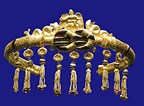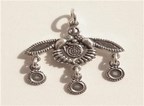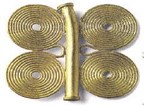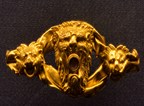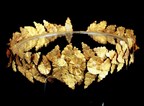The history of ancient Greece is very much influenced by the beauty of women. Women of Greece used to specially take care of themselves by wearing luxurious cotton, flax, and wool woven clothes along with jewelry made of gold bronze and gem stones. They used to take special care of their skin by using olive oil to be massaged on their bodies and used to take a bath from goat milk. Many ancient women wanted to have the title of the Greek beauty goddess. From those early times till today ancient Greek jewelry is very much common and liked among men and women. Today their jewelry style is replicated while ancient jewelry is available for display in many museums across the Greek land. The most famous ones are in the National Museum of Athens. The ancient Greek jewelry very commonly consisted of gold beads which were shaped in beautiful shells, beetles, flowers, leaves and other natural shapes. The Greek gold makers and smiths were very much inspired by the natural beauty and thus ornamented various jewelry into shapes of the natural beauties such as small insects, shells from the seas and flowers planted across the Greek. Many archeologists made different excavations and found beautiful necklaces earrings, rings, bangles, and chains from different sites. Most of them were buried while others were worn by different corpses which were mummified and were buried in coffins or tombs.
The people of ancient Greece were enthusiasts of jewelry and wore simple and complex designs. The jewelry used to make exclusive designs and they choose gemstones such as pearls, garnets, amethysts and emeralds. Apart from all these gemstones, the Greek craftsmen used to provide jewelry makers with glass stones and enamel stones which were colored. There were many types of Greek jewelry which was unique in their own way. On many of the storm’s images of Greek gods were printed such as Nike, Aphrodite, Artemis and Eros. Many of the Greek jewelry were designed in the shapes of different animals which were then worn by women on the necks or pierced ears. Greek women used to wear pendent ears which was jeweled with images of Greek gods and animals, this type of jewelry was part of the fashion of those times and usually women from higher classes used to wear them to differ themselves from the lower classes.
The most famous Greek jewelry types were the ones women used to wear on the neck and in the ears. Ornamental pendants were also very famous around the ancient Greek times. These ornaments pendants were two handled vases which were decorated with gemstones and colored glasses. These pendants were hung by a rosette. Other types of ancient Greek jewelry included spherical or wide chains of gold which was clasped with heads of animals or shapes or dolphins and doves. Greeks loved wearing gold wreath as headdresses which were very decorative; these were ornately adorned with crowns, images, foliages and flowers. With the advancement of techniques and designs, the ancient Greek designed Laurel headdress which was worn at the crown of honor or thrones. These headdresses represent Apollo who was the God of intelligence and divination.
From its wide popularity in loving ancient jewelry to the modern times, the richness of purple color of amethyst has made it most adored gemstone for decorating different types of unique jewelry pieces and sets. This purple gemstone had been used by people of ancient Greece who were authoritative positions. This gemstone was symbolized as the spirit of God. The designs of ancient Greek jewelry are just countless; their ideas were numerous and so could not be recorded. Embossing gemstones, creating rippled designs, outlining with borders and other such innovation in the jury added a very creative and unique feature to the ancient Greek jewelry. Many magnificent necklaces are center of attraction for many of ancient jewelry and even today they are attracting millions of jewelry lovers from all over the world.
The unique Greek jewelry has won appreciation and admiration by millions of people. Their simple designs, plain looks, flexible jewelry are suitable to be worn at any occasion. In the current times we have seen women wearing a Greek cross in anklets and also in necklaces and charm bracelets. Different types of jewelry were produced in Hellenistic period which included earrings, pendants, necklaces, arm bands, thigh bands, rings, diadems, wreaths, and others. The bracelets worn by Greek women used to be in sets or by wearing just a pair. In the Hellenistic times jewelry was, mostly passed on to the generations. They were dedicated sanctuaries which were offerings to the Gods.
The Greek history is full of many things which are used to glorify beauty. If today you are wondering where did the fashion of arm bands, thigh bands and the anklets come from then they were ideas of the ancient Greeks. The people of ancient times were creative in their own way. They used their imagination; they were inspired from nature and their Gods. This inspiration of them was displayed on the jewelry and artifacts they designed and presented to the people. Greeks used to wear jewelry in many occasions and sometimes all day and all night. Many of the women and men were buried with jewelry and many of their corpses were cremated and mummified so that they remain reserved for the upcoming generation to witness their boat and royalty. If you are wondering from where did the trend of taking bath from goat milk came from, then this was the royal treatment the Greek women used to have to make their complexion fair. The women of the Greek were known for their beauty and their beauty was made glorious by the jewelry they wore, the long and short dresses they wore which was designed in their unique way, and by the way their skin which the wanted to to be flawless.
